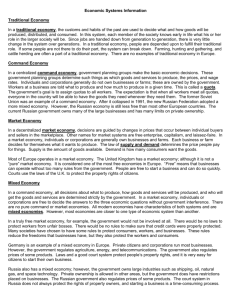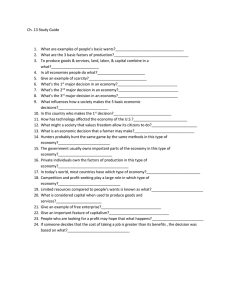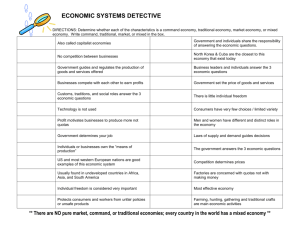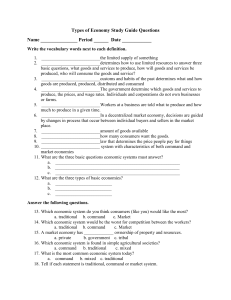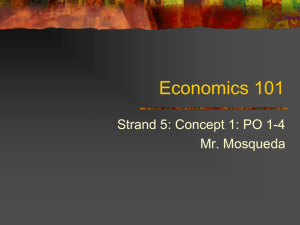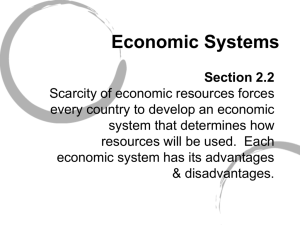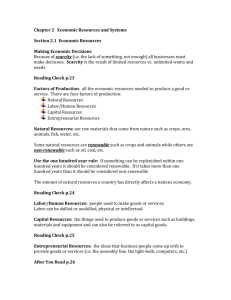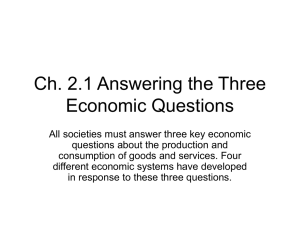Comparing Types of Economies
advertisement
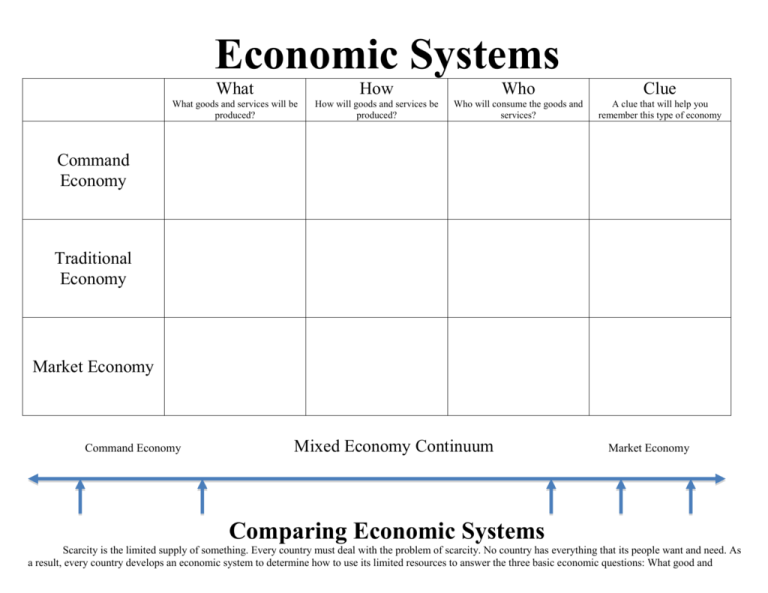
Economic Systems What How Who Clue What goods and services will be produced? How will goods and services be produced? Who will consume the goods and services? A clue that will help you remember this type of economy Command Economy Traditional Economy Market Economy Command Economy Mixed Economy Continuum Market Economy Comparing Economic Systems Scarcity is the limited supply of something. Every country must deal with the problem of scarcity. No country has everything that its people want and need. As a result, every country develops an economic system to determine how to use its limited resources to answer the three basic economic questions: What good and services will be produced? How will goods and services be produced? Who will consume the goods and services? The way a society answers these questions determines its economic system. In a traditional economy, the customs and habits of the past are used to decide what and how goods will be produced, distributed, and consumed. In this system, each member of the society knows early in life what his or her role in the larger group will be. Since jobs are handed down from generation to generation, there is very little change in the system over generations. In a traditional economy, people are depended upon to fulfill their traditional role. If some people are not there to do their part, the system can break down. Farming, hunting and gathering, and cattle herding are often a part of a traditional economy. There are no examples of a traditional economy in Europe. In a centralized command economy, government-planning groups make the basic economic decisions. They determine such things as which goods and services to produce, the prices, and wage rates. Individuals and corporations generally do not own businesses or farms; the government owns these. Workers at a business are told what to produce and how much to produce in a given time. This is called quota. The government’s goal is to assign quotas to all workers. The expectation is that when all workers meet all quotas, everyone in the country will be able to have the goods they need when they need them. The former Soviet Union was an example of a command economy. After it collapsed in 1991, the new Russian Federation adopted a more mixed economy. However, the Russian economy is still less free than most other European countries. The government owns many of the large businesses and has many limits on private ownership. In a decentralized market economy, decisions are guided by changes in prices that occur between individual buyers and sellers in the marketplace. Other names for market systems are free enterprise, capitalism, and laissez-faire. In a market economy, individuals or corporations generally own businesses and farms. Each business or farm decides what it wants to produce. The law of supply and demand determines the price people pay for things. Supply is the amount of goods available. Demand is how many consumers want the goods. Most Europe operates in a market economy. The U.K. has a market economy. It is considered one of the freest economies in Europe. “Free” means that businesses can operate without too many rules from the government. People are free to start a business and can do so quickly. Courts use the laws of the U.K. to protect the property rights of citizens. There are no pure command or market economies. All modern economies have characteristics of both systems and are mixed economies. However, most economies are closer to one type of economic system than another. In a truly free market economy, for example, the government would not be involved at all. There would be no laws to protect workers from unfair bosses. There would be no rules to make sure that credit cards were properly protected. Many societies have chosen to have some rules to protect consumers, workers, and businesses. These rules reduce the freedoms that businesses have, but they also protect the workers and consumers.
